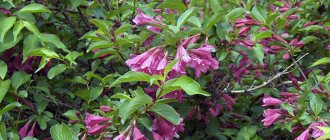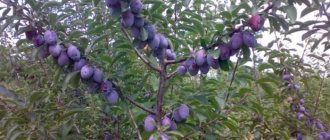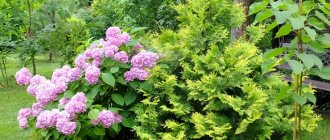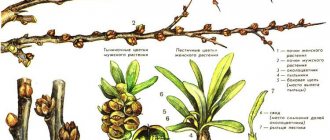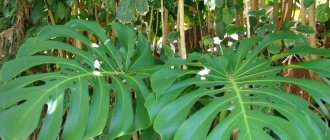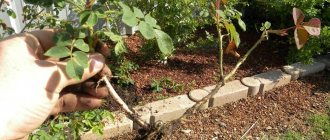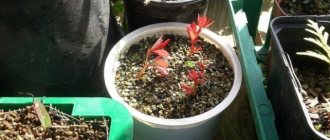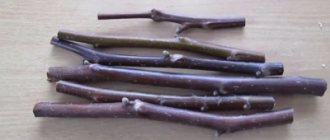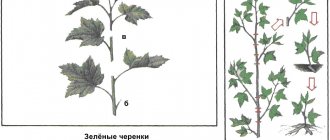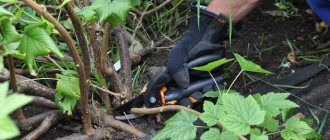By layering
To propagate linden by stem layering, you need to dig shallow longitudinal depressions, bend the lower branches of the tree, and then bury them.
Rooting occurs within 1-2 years. Then, the sprouted shoots can be separated and transplanted to a new location. It is important that the propagation process in this way occurs at the beginning of spring, when the leaves have not yet begun to bloom. You can propagate by root layering. This method is considered one of the simplest and most popular. Young shoots grow near the trunk of an adult tree in spring. To transplant, they are carefully separated from the “mother” root and planted immediately in the chosen place. In this method of propagation, young seedlings can be transplanted from the forest belt to garden plots.
You can propagate by root layering. This method is considered one of the simplest and most popular. Young shoots grow near the trunk of an adult tree in spring. To transplant, they are carefully separated from the “mother” root and planted immediately in the chosen place. In this method of propagation, young seedlings can be transplanted from the forest belt to garden plots.
Linden planting and care
How to plant a linden tree on a plot using cuttings? To do this, you must first prepare the soil. Tree shoots are planted only in dug up soil fertilized with humus, compost and wood ash.
Linden is harvested for cuttings in the fall. In the early morning or in cloudy weather, planting material is cut from an adult tree. The lower cut of the cutting is made oblique 10 mm below the bud. The upper one is performed at a right angle above the kidney. This reduces moisture loss.
An ideal linden cutting is a planting material with certain parameters. It should not be frail and thin. From such material, a full-fledged tree will not grow very soon or will not grow at all.
A good cutting has the following parameters:
- 8-15 cm length (minimum 4 knots on the workpiece);
- green flexible shoot with full leaves (almost all foliage is removed during the preparation process).
Prepared cuttings should be placed in water before planting in the ground. It is in it that the linden root system should gradually develop. To speed up this process, Kornevin is added to the liquid. This drug stimulates root formation and shoot adaptation.
Preparing planting material is a fairly simple procedure. However, it requires careful adherence to a certain temperature regime. Linden shoots awaiting root formation should be in an environment with a temperature of at least +25 degrees. Only with this regime can you count on rapid root formation.
Linden propagation by cuttings occurs in the spring. Planting material is harvested in the fall. It must be saved until spring planting. To do this, the selected shoots should be collected in a bunch. Next, they need to be placed, roots down, in a container filled with wet sand. Containers with cuttings should be stored in a room with a temperature of up to +4 degrees. You can choose a basement or refrigerator as a storage place.
How to plant linden in spring? Before burying the cuttings in the ground, they should be placed in water for a while. It is recommended to add Kornevin to the liquid as a growth stimulator. The linden tree is directly planted in previously prepared soil. The cuttings are buried in the soil to a depth of no more than 1.5 cm. The distance between the young shoots in this case is about 10 cm. After the planting procedure, the shoots should be watered with soft, strained water. In open areas, it is recommended to shade or cover young plants.
What types of linden trees are there?
In Russia there are several species of trees under the common name linden.
One of the most common species is the heart-shaped linden. It is distinguished by heart-shaped leaves. It is widespread in European and Western Siberian territories. The trees grow more than 30...35 m. They have a long lifespan. In the Tula and Kaluga regions there are trees that are about 800 years old. They say that there are also those that began their growth during the years of the Baptism of Rus'.
On average, mature trees survived the 1917 revolution and grew during the Great Patriotic War. The leaves have a dark green color on top and a bluish surface on the back. Inflorescences can have up to 5...12 buds.
- Large-leaved linden is common in the forests of the Central Zone. Its habitat is quite extensive; in the Urals, this type of linden produces the most famous Bashkir honey. It is found in the Moscow region and also grows in the parks of Paris. The leaves are about one and a half times larger than those of the heart-shaped linden. It has been noticed that its flowering begins in the second ten days of June. Flowering lasts until the end of the first ten days of July (in the northern regions, flowering begins in the first ten days of July). The lower surface of the leaves is pubescent. It is this variety that can purify the air in cities. Dust particles settle on the pubescent surface. The color is green, without shades of bluish. The ripe fruit has a dense shell with five ribs visible on it.
- In the south, in the Rostov region, the northern Caucasus, Crimea and the Lower Volga region, felt linden is common. In Europe, this breed is found in Bulgaria, Hungary, the former republics of Yugoslavia and the Apennine Peninsula.
- The tree often grows up to 21...32 m. It is distinguished by a powerful spreading crown. There are villi on the surface of the leaves. Dark green color predominates on the upper side, with a silvery tint underneath. This species of linden is distinguished by its high drought resistance. Grows well in warm climates. May bloom from early June to mid-August. However, during dry times, nectar may not be available to bees. Therefore, they can collect honey only in the early morning, when the air temperature does not exceed +22...25 ⁰С.
- In the Far East, China and the Korean Peninsula, Manchurian linden is widespread. The height is slightly lower than that of the varieties described earlier, the trees grow no more than 15...17 m. The leaves are heart-shaped, but there are no sharp differences in the color of the lower and upper sides. Only the pubescence is noticeable from below, which gives a lighter shade. Flowering is long-lasting, beginning in mid-July. Lasts up to 20…25 days. It is an excellent honey plant for local bees.
How does linden reproduce in other ways?
Planting linden in the fall can be done using seeds, cuttings and seedlings. In the first case, sprouted seeds are used to obtain an adult tree. Material collected after flowering should be stored for at least 2 months in a humid place. During this procedure, a stable temperature of 0 degrees is maintained. After a certain period of time, sprouts appear in the linden seeds. This means it’s time to plant the material in open ground. This method of tree propagation requires careful watering. Using seeds you can grow a healthy linden tree. However, its flowering will occur only after 20 years. Much earlier you can get a plant using layering or seedlings.
Propagation of linden by cuttings is excellent for this deciduous tree. This method does not require much effort, time or money. It can be used in open ground, greenhouse or greenhouse. To propagate a tree in this way, lightly drained soil should be used. You need to start doing this procedure in the fall.
Seeds in linden fruits
Most often, this tree reproduces by seeds. Around mid-July, the linden tree begins to bloom (depending on weather conditions, this may happen earlier or later). The flowering of the plant is not very long, as a rule, it lasts about ten to twelve days, after which, in place of the fragrant flowers, small grains-fruits are formed, in which one or two seeds are hidden.
These fruits can be collected and planted in two ways: when they are already fully ripe and have acquired a brown tint (that is, in the fall) or when the fruits have barely turned yellow, almost immediately after the end of flowering.
However, in the first case, seeds planted in the fall germinate in two and sometimes three years, so many experts recommend using immature seeds for sowing.
Linden planting and care
How to plant a linden tree on a plot using cuttings? To do this, you must first prepare the soil. Tree shoots are planted only in dug up soil fertilized with humus, compost and wood ash.
Linden is harvested for cuttings in the fall. In the early morning or in cloudy weather, planting material is cut from an adult tree. The lower cut of the cutting is made oblique 10 mm below the bud. The upper one is performed at a right angle above the kidney. This reduces moisture loss.
An ideal linden cutting is a planting material with certain parameters. It should not be frail and thin. From such material, a full-fledged tree will not grow very soon or will not grow at all.
A good cutting has the following parameters:
- 8-15 cm length (minimum 4 knots on the workpiece);
- green flexible shoot with full leaves (almost all foliage is removed during the preparation process).
How does linden reproduce in other ways?
Planting linden in the fall can be done using seeds, cuttings and seedlings. In the first case, sprouted seeds are used to obtain an adult tree. Material collected after flowering should be stored for at least 2 months in a humid place. During this procedure, a stable temperature of 0 degrees is maintained. After a certain period of time, sprouts appear in the linden seeds. This means it’s time to plant the material in open ground. This method of tree propagation requires careful watering. Using seeds you can grow a healthy linden tree. However, its flowering will occur only after 20 years. Much earlier you can get a plant using layering or seedlings.
It is the cutting method that most gardeners choose to propagate linden trees. The thing is that this plant takes root very easily and can grow in any type of soil. But, of course, for the splendor of the crown and abundance of flowering, the tree should be properly cared for.
In the forest, the plant does not have to choose, and it grows without requiring fertilizing or processing. However, in the garden, in order to maintain the decorative appearance of the linden tree, it is necessary to create comfortable conditions for it: promptly clear the tree trunk of weeds, water it and at least occasionally fertilize the soil.
Based on the assumption that seedlings are planted in open ground in the spring, cuttings of the plant and preparation of the site for future plantings should begin in the fall. The soil in the area designated for linden cultivation is well dug up to the depth of a shovel, fertilizers are added to it - preferably humus or compost plus wood ash, and finally the surface is leveled using a garden rake and covered with polyethylene for the entire winter season.
It is worth saying that this tree can be successfully propagated in other ways: by layering, using root shoots, and seeds. But propagation of linden by cuttings, although a rather labor-intensive method, is used by gardeners quite often.
Cuttings are cut from an adult tree in the early morning or in cloudy rainy weather - this significantly reduces the percentage of moisture evaporated from the shoot. The upper cut is made above the bud at a right angle, in order to also minimize moisture loss by reducing the evaporating surface. The lower cut is made obliquely, 1 centimeter below the kidney.
The main parameters for choosing branches for cuttings are diameter and length. Planting material from a thin shoot will develop very slowly, and given that the linden tree already blooms only a couple of decades after planting, this is unacceptable. The optimal length of the cutting is determined by the number of nodes, of which there must be at least four, this is 8-15 centimeters. For cuttings, only green and flexible shoots with fully formed leaves are used.
Each cutting is placed in a separate container with water, in which a drug such as Kornevin or Epin is pre-dissolved - these products are designed to stimulate root formation and help plants during the period of adaptation to new conditions. After half an hour, the water from the container should be drained and replaced with fresh water - in it the shoots will wait until the root shoots appear.
It is important to ensure that in the room where the cuttings are located while waiting for the development of the root system to begin, a constant air temperature is maintained at least +25 degrees.
It is not enough to be able to properly prepare cuttings in the fall; you also need to preserve them until spring planting, and this can be a difficult process, especially for a novice gardener. All shoots should be loosely tied into one bundle and placed in a container filled with damp sand, roots down. The air temperature in the room should vary from 0 to +4 degrees - this could be a basement, cellar or refrigerator, if there are few branches and they will not interfere.
Growing linden using cuttings
Growing a tree such as linden is best done using cuttings. This plant can grow in any soil. However, you will have to pay for the beautiful, lush leaves and crowns with decent care.
To maintain a decorative appearance, you will often have to clear the tree trunk of weeds. It is also recommended to drain the area and loosen the soil before planting. You will have to water and fertilize it less often. It is recommended to dig it up to the height of the shovel. It is better to prepare the preparations in the fall in order to plant them in open ground in the spring. The soil, which contains fertilizers such as humus, compost, ash, is leveled with a rake and left covered with polyethylene for the winter.
Selection of cuttings
Cuttings are cut either in the morning or in cloudy weather. This is done in order to reduce the percentage of evaporated moisture. The upper cut is made above the kidney, and the lower one is approximately 1 cm below the kidney. If the top is cut at a right angle, the bottom is left with an oblique bevel. An important criterion for selecting cuttings is length. It should be 10-15 cm. In order to plant a linden tree, you will need flexible green shoots. Then they are placed in a glass of water, after stirring the plant preparation. Koverin will cope with this task. After half an hour of the cuttings standing idle in water with medicine, it is changed to a new one. It is in it that the cuttings will germinate. An important condition is to maintain the temperature at least 25 degrees.
Storing cuttings in winter
All cuttings need to be tied in a bunch and stored in a container. The container container should be filled with wet sand. Cuttings will be well preserved at temperatures from 0 to 4 degrees. A basement or cellar is an excellent place for storage. If there are not many branches, then you can put the cuttings in the refrigerator. Before planting, the cuttings are also washed in water with Koverin.
Landing
Seedlings about half a meter high are planted in a hole with a diameter equal to the height of the cutting. Drainage is placed at the bottom. This could be rubble or brick fragments. The next layer is fertilizer - humus or compost. A seedling is placed in this mixture, and the remaining space in the hole is covered with humus and soil. The final stage is to water the planted tree and sprinkle it with ash. In abundant sunlight, young trees are covered with film.
Weeds can harm a planted linden tree. Therefore, it is necessary to combat weeds by treating the soil with herbicides. A cheaper method is to use a large amount of salt diluted in a small container of water. Simply water the soil with this solution.
In order to grow a linden tree, all you need to do is prepare cuttings. This method, although labor-intensive, can grow a beautiful tree with a long lifespan.
Sources: https://lenpas.ru/stati/vyrashhivanie-lipy-s-pomoshhyu-cherenkov.html https://fermersadovod.ru/sad-i-ogorod/derevya/kak-podgotovit-plodovye-derevya-i-kustarniki -k-zime/
Linden: description, useful properties
Linden is a long-liver: in terms of its lifespan it can surpass most trees known to us. So, on average, a linden tree can live about 500 years. It begins to bloom quite late: only in the 20th year of its life (if it grew up in natural conditions). Under artificial conditions, linden produces its first flowers only at the age of 30.
Linden is known to everyone for its honey-bearing properties: from the nectar of one single tree you can get about 16 kg of high-quality, aromatic, surprisingly healthy honey per season.
Linden blossom is actively used in folk medicine: it is dried and stored for several years in small bags made of fabric or paper.
16 excellent varieties of plums for the Moscow region
Fragrant linden tea can become not only a pleasant-tasting drink, but also a valuable source of glucose, carotene and other substances beneficial to our body. Linden tea will help get rid of fever, eliminate inflammation in the body, and also have a pronounced diuretic, diaphoretic, and choleretic effect.
In addition to color, linden bark is also actively used for medicinal purposes, which can heal open wounds, treat burns, eliminate dermatological problems, etc.
Attention! Drinking linden tea is contraindicated for people suffering from cardiovascular diseases, since linden has a pronounced ability to accelerate metabolic processes, which puts a high strain on the heart.
Most often, linden grows in groups, but in natural conditions, oppressed by stronger representatives of the flora, it can take on the appearance of a tall shrub. Linden is an unpretentious tree, so its species (and there are a huge number of them) are actively grown for decorative purposes: for landscaping parks, streets, alleys, etc. After all, nothing will decorate a linden tree better than an even row of slender linden trees with a neat crown, which will bloom magnificently and fill the entire area with a thick sweet aroma.
Brief characteristics of linden
If you look at the map of the Central region of the Russian Federation, then in each region you can find small villages, towns and even a city called Lipki. It was not without reason that this name was given. Long before entering the populated area (the town of Lipki, Tula region), linden trees grow around the road. They show where a settlement is located.
On July days, they remind you of themselves with their honey smell and bright yellow color. Residents of Lipki collect flowers from the lower branches; the strength of a hot summer day remains in it for a long time. It can be absorbed by brewing tea from flowers.
As experiments have shown, from one mature tree, in 10...15 days of honey collection, bees bring up to 15...20 kg of nectar, which turns into 8...11 kg of honey. And what happens along the alleys located along the roads or forests and parks?
But the plants do not bloom immediately. They need to grow for at least 18...22 years before the first color appears. This fate is typical for most trees planted with seeds. If vegetative propagation has occurred, then already in the third year the small seedling becomes covered with color.
Carving masters love wood for its pliability and special softness of solid white wood. Figures of people and animals are cut out of it. They perform complex paintings with an intricate plot. In the old days there were icon painters who worked not with paints, but with cutters. In their skillful hands, the faces of saints appeared on linden boards.
During wars and other disasters, the tree bark was used. It was used to heal open wounds. Thin sections were used to treat burns. They even offered to chew it so that the juice would help the body from the inside.
Currently, when planting in parks and even when expanding forests, linden is given special importance. An unpretentious tree can grow in a variety of conditions. It is not demanding on soils. Powerful roots can grow even in heavy soils.
The main methods of linden propagation (shoots, cuttings, layering)
Linden propagation is carried out in several ways, but only the following can be highlighted:
- Overgrowth . During the period of active tree growth, small shoots that appear under the linden crown can be used as material for planting young trees. Small shoots are excellent for transplanting, but several conditions must be met. Firstly, planting time is strictly spring; secondly, the weather is extremely wet and cool. As seedlings, it is better to choose two-year-old shoots with a fairly developed root system (such specimens usually grow at a distance of 2-3 m from the tree). So, the taproot must be cut on both sides of the shoot, after which you must carefully care for it throughout the summer: loosen the soil around it, water the young plant, apply fertilizer, and plant it in the main place in the fall.
- Layerings . An unusual method of linden propagation, which, however, is also used. The process is carried out as follows: a young tree is cut down, and then wait for sprouts to appear on the stump. One- or two-year-old shoots are bent to the ground and secured near it with wooden devices. Afterwards they are carefully sprinkled with earth. After a couple of years, roots will appear at the bend site. Then you should carefully separate the young plant from the mother plant with a sharp shovel and then replant it.
Folk recipes
A decoction of dried linden flowers is applicable in cases of lobar pneumonia, rheumatic pain and pre-fainting conditions. A decoction of freshly picked flowers in equal proportions with sage helps get rid of kidney pain, and with the addition of soda it is used as a gargle for sore throat and stomatitis. Lotions and poultices help relieve inflammation in hemorrhoids, gynecological problems, ulcers and swelling.
Linden wood or branches, dried and crushed, are used as an adsorbent of toxic substances for food poisoning. Linden charcoal is used for pulmonary tuberculosis, gastrointestinal problems and bleeding open wounds. Tar, obtained from linden wood, is applied to areas of skin affected by eczema.
Boiled young bark, slippery to the touch, is good for treating burns and abscesses. For the same purposes, you can use crushed buds and leaves of the tree. Linden fruits, ground into powder and soaked in vinegar, stop bleeding. Placed on the head, linden leaves relieve headaches.
Linden planting and care
How to plant a linden tree on a plot using cuttings? To do this, you must first prepare the soil. Tree shoots are planted only in dug up soil fertilized with humus, compost and wood ash.
Linden is harvested for cuttings in the fall. In the early morning or in cloudy weather, planting material is cut from an adult tree. The lower cut of the cutting is made oblique 10 mm below the bud. The upper one is performed at a right angle above the kidney. This reduces moisture loss.
An ideal linden cutting is a planting material with certain parameters. It should not be frail and thin. From such material, a full-fledged tree will not grow very soon or will not grow at all.
A good cutting has the following parameters:
- 8-15 cm length (minimum 4 knots on the workpiece);
- green flexible shoot with full leaves (almost all foliage is removed during the preparation process).
Prepared cuttings should be placed in water before planting in the ground. It is in it that the linden root system should gradually develop. To speed up this process, Kornevin is added to the liquid. This drug stimulates root formation and shoot adaptation.
Preparing planting material is a fairly simple procedure. However, it requires careful adherence to a certain temperature regime. Linden shoots awaiting root formation should be in an environment with a temperature of at least +25 degrees. Only with this regime can you count on rapid root formation.
Linden propagation by cuttings occurs in the spring. Planting material is harvested in the fall. It must be saved until spring planting. To do this, the selected shoots should be collected in a bunch. Next, they need to be placed, roots down, in a container filled with wet sand. Containers with cuttings should be stored in a room with a temperature of up to +4 degrees. You can choose a basement or refrigerator as a storage place.
How to plant linden in spring? Before burying the cuttings in the ground, they should be placed in water for a while. It is recommended to add Kornevin to the liquid as a growth stimulator. The linden tree is directly planted in previously prepared soil. The cuttings are buried in the soil to a depth of no more than 1.5 cm. The distance between the young shoots in this case is about 10 cm. After the planting procedure, the shoots should be watered with soft, strained water. In open areas, it is recommended to shade or cover young plants.
How does linden reproduce in other ways?
Planting linden in the fall can be done using seeds, cuttings and seedlings. In the first case, sprouted seeds are used to obtain an adult tree. Material collected after flowering should be stored for at least 2 months in a humid place. During this procedure, a stable temperature of 0 degrees is maintained. After a certain period of time, sprouts appear in the linden seeds. This means it’s time to plant the material in open ground. This method of tree propagation requires careful watering. Using seeds you can grow a healthy linden tree. However, its flowering will occur only after 20 years. Much earlier you can get a plant using layering or seedlings.
